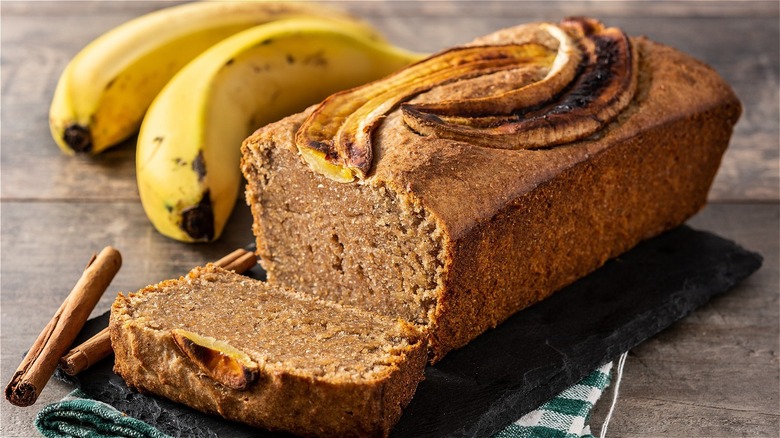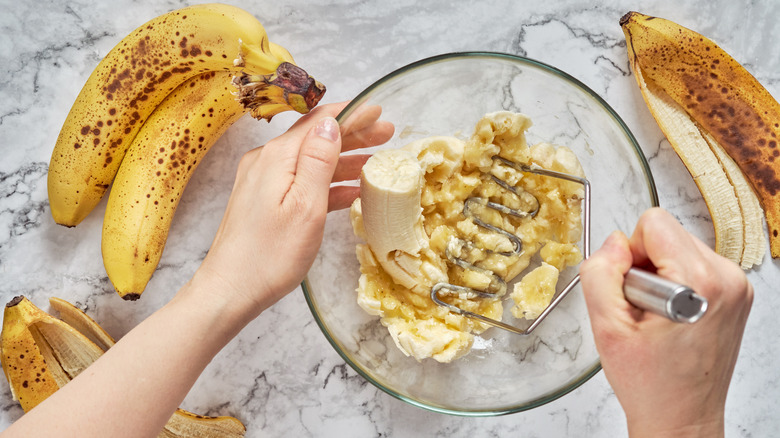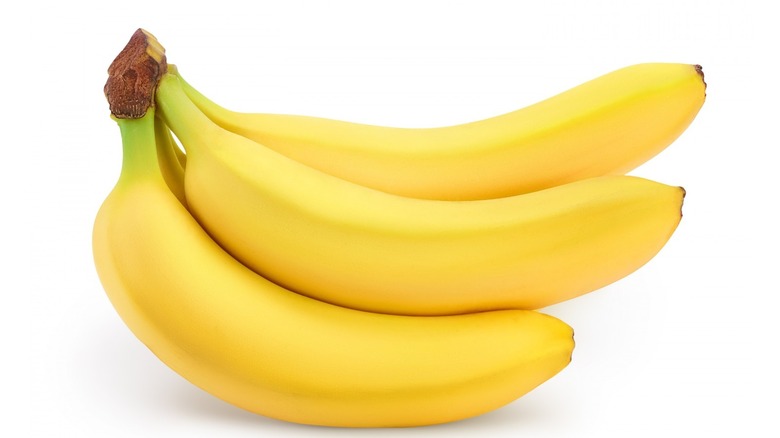The Easy Way To Prevent Moldy Banana Bread
Banana bread has made a comeback. Actually, the beloved breakfast-snack-dessert never went away. But during the COVID-19 lockdown, baking banana bread became more popular because it was easy to make with ingredients already on-hand. It was also a perennial comfort food at a time when we needed some comfort and it was inexpensive at a time when many of us were feeling insecure about our next paycheck. Additionally, it provided nutrition while satisfying our sweet tooths and it was a great way to send some cheer to our neighbors.
During the Great Depression, baking banana bread became popular in American households for similar reasons. When every scrap of food was precious, even overripe bananas thought to be rotten turned out to have a delicious purpose, according to King Arthur Baking, which named banana bread the most searched bread recipe on the internet.
If you have any baking experience, you probably know that you will need to mash up a bunch of super-ripe bananas for your recipe. Other baking tips may not be as obvious. We at Mashed have gathered some tips on baking banana bread — including how to avoid making common mistakes. One such mistake can cause your banana bread to get moldy. Whether you were baking in 1929 or 2020, banana bread leftovers didn't last long. But now that our lives are resuming at a busier pace, it may be hanging around long enough to go bad. Here's how you can avoid your delicious loaf growing mold.
Cool your banana bread to prevent mold
Sure, banana bread tastes wonderful while it is still warm from the oven, but don't let the bread sit in the pan for long, according to Allrecipes. The bread bottom will get soggy, increasing the opportunity for it to get moldy later. Warm bread wrapped in plastic wrap leads to condensation which leads to mold.
Instead, allow the bread to cool completely on a rack — about 15 minutes — before inverting the pan and using a spatula to coax the loaf onto a plate. Then wrap it in plastic or transfer it to an airtight container.
Another advantage to cooling the bread is it firms up the banana mash, which also makes it easier to cut without slices falling apart.
Other tips: Don't forget baking is based on science so it's important to follow the recipe's order and use the exact measurements. Don't use a wet measuring cup for dry ingredients like flour. It will throw off the amount. A wet cup, with a handle and spout, won't allow you to pack down the dry ingredients, which may distort your amount and recipe outcome.
Use the right amount of bananas
The more bananas the better. Right?
For great chocolate chip cookies, add more chocolate (duh). For a creamier ice cream texture, add more butterfat. For the best banana bread, add more ripe bananas? After all, it is the banana that makes it so moist and tasty. Nope, says Allrecipes.
The website recommends resisting the temptation to use more bananas than are called for. Using a lot of bananas could make your bread too heavy in the center, which leaves it looking wet and undercooked.
What if you have the opposite problem — not enough ripe bananas? You can use a quick-ripen method, such as placing bananas on a baking sheet and into a 300-degree oven for 20 minutes. Or freeze ripe bananas to use the next time you bake the bread (or make smoothies).
Banana bread is perfect in its simplicity, but if you want to give yours a signature touch, switch up the kind of flour, or add fruit, or nuts. Other additions: spices, chocolate chips, or cookie butter. Want to keep the flavor but change the form? Go for banana bread cookies or banana nut muffins. For two comfort foods in one, add oats. But if you want to make sure your banana bread doesn't grow mold, the answer is to take steps to keep it from being too moist.


